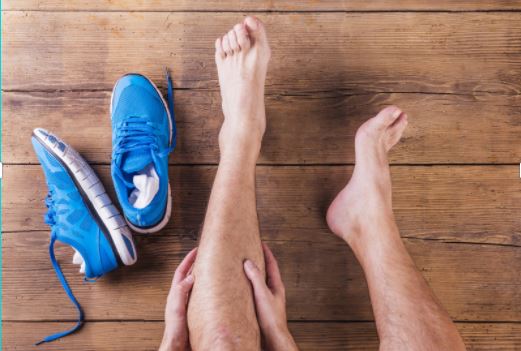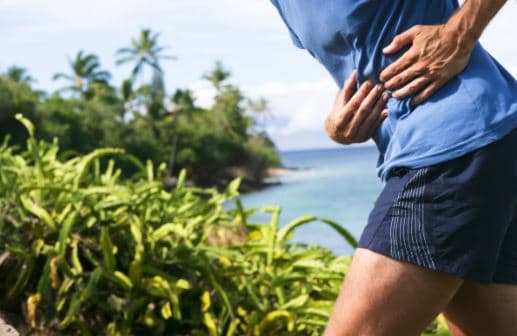I know you’ve been there. You’re just be-bopping along on your run, enjoying being outside and getting your feel-good exercise on when out of nowhere a twinge of pain starts to form somewhere in your body. Perhaps it’s growing discomfort in your side or pain that’s causing your leg to seize up…either way, you know it’s not good. Running cramps are the pits, and they can turn an enjoyable run sour very quickly. It may seem like something you just have to deal with, but luckily there are ways to prevent and treat running cramps.
But, why do runners even get cramps? There are multiple types of running cramps that afflict parts of a runner’s body for various reasons. Some of the most common causes of running cramps include: shallow breathing, making a poor fueling choice, dehydration and electrolyte imbalance, and over training.
Though experiencing cramps while running is common, there are ways to combat them. Here you’ll find out about different types of cramps runners get, causes of each of them, and what you really came for – how to stop them from derailing your runs so you can return to your gazelle-like status.
Types of Cramps You Might Get When Running
Runners are plagued by different types of cramps for different reasons. Even those runners who’ve finally figured out the recipe for avoiding said cramps still have memories of the discomfort they can cause and how easily they can sabotage a good run(or worse, a race). Our goal here is to get you in the latter category…making cramps a distant memory.
Chances are, the type of cramp you get on your sprints is different from the cramping you got during your last marathon. Not all cramping is created equal – several areas of your body can be affected and the cramping may be light or quite painful.
The types of cramps most commonly reported by runners includes:
- Side Cramps
- Stomach Cramps
- Leg and Calf (Muscle) Cramps
- Foot and Toe Cramps
There is often a different cause for one type of cramp compared to another. For example, your stomach cramps aren’t happening for the same reasons as your toe cramps.
Next we’ll cover what the root causes could be for each type of cramp, how you can help alleviate the cramping in the moment, and how to prevent that same cramping from coming back.
Causes and Prevention of Cramps While Running
As much as you’d love running to be a simple exercise (seems like it should be, right?!), once you start pushing the pace and distance, you need to take care of your body a bit more.
Unfortunately our bodies aren’t machines, so when we add stress upon them certain organs, joints, etc. may push back and say, “Whoa there, buddy, that’s too much.” Whether it’s too much food, adding mileage too soon, or running fast too often, your body might let you know it’s not happy in the form of cramping.
So let’s talk about each type of cramp, why it happens, and what you can do to stop it from recurring.
Side Cramps (Side Stitches)
Side cramps, often referred to as “side stitches” are that sharp pain that you get directly under your abdomen…usually on the right side. I’ve gotten them from time to time in my running career, but distinctly remember these plaguing me in gym class when we had to run the dreaded mile-long “square.”

What causes side cramps while running?
One common cause of side cramps comes from the irregular breathing pattern that occurs when your heart rate speeds up. Inexperienced runners are often the ones plagued by these painful side stitches because they haven’t yet learned how to breathe evenly when picking up the pace and instead, they’re often gasping for air.
All that gasping leads to a shallow, uneven pattern of in-and-out breaths that don’t completely fill up the lungs to get in a full breath of air. This disrupts your diaphragm’s rhythmic pattern.
Though there isn’t yet conclusive evidence of this, it’s thought that the stabbing pain of a side stitch on the right hand side is due to the liver being the diaphragm’s referred area of pain (a feeling of pain perceived in a different part of the body).
How to Prevent Side Cramps While Running
So let’s talk about what you can do to keep those side cramps from coming back:
- Warm up first. This gets the blood flowing and your body ready for your next move without it feeling like it’s been jolted into action.
- Slow down. I’m not saying you can’t ever run fast, but if you’re a beginner runner who is getting side cramps often, it’s likely you are trying to go too fast as your body learns to adapt. Going easy as you begin training will help you take time to pay attention to your breath.
- Focus on getting in longer, full breaths. If your breaths feel like they’re stopping in your chest, that’s not far enough. Work on extending those lungs down to your stomach while keeping the duration of an in breath the same as the out breath.
If you still find yourself with a side stitch, try this: Whenever I get a side stitch, I slow down immediately. I calm my breathing and take full inhales and exhales. While doing this, I push directly on the site where I’m feeling pain. I basically curl up my fingers under my ribcage and push on the cramp. This gets my breathing back on track and works for me every time!
Stomach Cramps
With stomach cramps, you probably know where this convo is headed. These are the cramps that lead you to wonder why you made the diabolical decision to consume a Big Mac the night before your sunrise long run, but truth be told, it’s not always as easy as pointing a finger to a single poor food choice (though those can definitely be culprits!)
And unlike side cramps that are more of a frustrating bother than a medical problem, recurring stomach cramps may be something that require a doctor visit which we’ll discuss.

What causes stomach cramps while running?
There are different reasons stomach cramps occur, and several stem from what you’re putting into it including food, drinks, and even medicine.
Let’s talk about each possible stomach cramp cause.
1.) Improper Food Intake – More likely than not, it’s your food choices that are leading to stomach cramps. The tough thing here is that every runner will be different when it comes to what they can handle eating before a run. Not waiting for a meal to fully digest as well as eating something that personally wreaks havoc on your digestive system (such as whole grains or dairy) can easily lead to stomach cramps. Ultimately, what you eat before a run and when, matters.
2.) Medicine – In my article, “Advil or Tylenol Before Running: Not as Harmless as You’d Think,” I discuss how taking pain relievers can disrupt your digestive system and cause stomach issues, specifically ibuprofen. If you frequently take ibuprofen before your runs and you get stomach cramps, this very likely could be the cause.
3.) Dehydration or Lack of Electrolytes – As a runner, you need to be take care that you’re getting in enough fluids. This is especially true for long runs and marathons, but short runs on a hot day can lead to dehydration, too (more on that here.) When you don’t, you can become dehydrated. The loss of electrolytes can cause stomach cramps, which is an early warning sign of dehydration.
4.) Too Much Hydration – Ever realize that you didn’t drink enough water the night before a run only to guzzle a ton immediately before to make up for it? I mean, A for effort on trying to be hydrated, but this could very likely backfire in the way of stomach cramps (hello, all that liquid sitting in your stomach as you jostle it all around).
How to Prevent Stomach Cramps While Running
Stomach cramps can be tricky for some runners to prevent, especially if they have sensitive stomachs. But I have some great tips for you to get you back on track.
Here’s what I suggest to cut the stomach cramps:
1.) Find the pre-run fuel/food that works for you and then stick with it. Like forever. You do not need a lot before you head out. Aim for 30 – 60 grams before a run. Err on the side of less for a finicky stomach and you can always build on that as time goes on. Here are a few great options that can work well:
- White bagel with Nut Butter (54 grams carbs)
- Banana with Nut Butter (33 grams carbs)
- Oatmeal with 1/2 Cup Berries (48 grams carbs)
- 1 Honey Stinger Waffle (these are SO good) and dried fruit (44 grams carbs)
- RX Bar (24 grams of carbs) or other energy bar – I know this is less than the recommended 30g carbs, but this is what I eat and have for a long time. It works for me!
Dr. Nina Franklin also has some great food ideas you might not think of.
See that I didn’t list dairy, whole grains or leafy green vegetables? You’ll want to avoid these if you’re experiencing stomach cramps. Read, “Fasted Running: When You Decide to Run on Empty,” to find out how not eating at all before a run could work for you, too.
2.) Eat at least an hour before your run. Not only is it about what you eat, but when you eat. Way back when, my husband and I used to eat these big spaghetti dinners (or similar) and then head out for a run within the hour for a run. We felt awful every time and could not figure out for the life of us why! Not only was it too much food, but we didn’t wait long enough for it to digest.
3.) Drink water often. Don’t wait til the morning of to hydrate, by then it’s already too late anyway. Focus on drinking plenty of water throughout the day in smaller doses. This way, your body will always be hydrated and you’ll never be jacking up the balance of electrolytes in your body that can make you feel ill.
4.) Sip water during your run. Just because you go into a run hydrated doesn’t mean you can’t get dehydrated during. In my article, “The Best Water Carrier for Runners,” I share that anyone going for a run longer than an hour should be drinking water during. Sipping water throughout your run is the best way to go to keep your stomach feeling its best (which is why I love running with my VaporHowe hydration vest so much!)
5.) Skip the ibuprofen. If you feel like you can’t get through a run pain-free without taking pain relievers, that warrants a trip to your doctor. There’s probably something else going on that needs to be examined and continuing to run like that can just hurt you more. If you take an occasional ibuprofen, no worries, you may just want to skip the run that day if you find it upsets your stomach.
If you find yourself with stomach cramping mid-run, here’s what I recommend. If stomach cramps arise while you run, what you ate and when is likely the cause. Try taking a few sips of water and slowing down to see if that helps. If it doesn’t, it’s probably time to head back home. Be proud of the miles you accomplished and then work on targeting the issue so that it doesn’t continue.
Leg and Calf Cramps
Runners with lower weekly mileage who stay consistent with this volume are less likely to get leg and calf cramps. It’s the endurance runners or athletes who have recently increased running mileage or speed who are more often plagued by these types of cramps. Let’s find out why.

What causes leg and calf cramps while running?
Leg and calf cramps occur within skeletal muscles, or the types of muscles that you move voluntarily. You are meant to move them, of course, but expecting them to do too much without acclimating to the particular exercise can lead to cramps.
These are top 3 reasons runners get leg cramps, which most often present themselves in the calf (or gastrocnemius muscle):
- Overtraining – Leg and calf cramps are often associated with overuse. Trying to do two hard runs back to back without a recovery run in between (more on that here) or building mileage by more than 10% week after week are two things a runner might do that might lead them to getting these cramps. They can be so bad, in fact, that they turn into a strained muscle and you’ll have to halt your running completely until it heals.
- Dehydration or Electrolyte Imbalance – Cramping that comes out of nowhere during a long run, marathon or ultra marathon could be caused by dehydration or an imbalance of electrolytes. If it’s really hot or you’re sweating excessivley, this type of prolonged running can lead you to a sodium deficit. In turn, you may feel cramping along the quads, hamstrings or calf muscle.
- Fatigue – Cramps can creep up when you are running mileage or speed beyond your comfort zone. It could be due to not properly warming up, but in a marathon, for example, it may just be that you’ve put a lot of stress on your legs and they are overworked.
How to Prevent Leg and Calf Cramps While Running
Prevention here can take time and practice, but the good news is that with proper training and recovery, you can avoid most of these pains from “cramping” your running style. Here’s what to do next:
1.) Don’t add mileage too quickly. As a new runner, it can feel exciting to keep adding more miles and speed. But done too quickly, and you will pay the price. It could be in leg muscle cramps, but could also present itself as Achilles tendonitis, or a host of other injuries. So follow the 10% rule. Only increase weekly mileage by 10% or less and never make your long run more than 10% longer than your long run the week prior. Additionally, be sure to always include recovery runs between any hard effort like a speed session or a long run. I go over how to any proper training plan should include recovery runs here.
2.) Go into your run hydrated. Similar to hydrating to keep stomach cramps away, you need to hydrate early and often. This means keeping hydration as a priority everyday, not just on days you run or before your run. Additionally, utilizing an electrolyte drink pre-run and during your run, such as Nuun Electrolyte Drink Tablets, will help keep your sodium levels balanced.
3.) Train properly. Leg cramping that’s a result of fatigue is somewhat par for the course. If you think it’s just sore legs, you can run through that, and it’s actually a good way to prepare for a marathon (meaning, you’re sore, NOT injured).
Otherwise, to keep constant fatigue away that keeps your from completing runs, you’re probably going hard too often. Keep those long runs easy (long slow distance is what some people like call them) and save the speed for mid-week. As far as keeping your legs from tensing up from fatigue late in a race, make sure you’ve prepared for your race. That means using a proper training plan with plenty of long runs. A 16-week marathon training plan is often not long enough to get a runner to their potential.
RELATED: Top Marathon Training Plans: The Basics You Need to Know
Here’s what I recommend to stop a leg and calf cramps mid-run: If you are in the middle of a long distance run, or an endurance race for that matter, you’re going to need a solution – and quick.
If it’s fatigue that sets in past that 20-mile mark of a marathon, there won’t be a lot you can do to fix it, but you CAN use your mental strength to push past it. Considering the 40% rule, your mind may be telling you that you can’t go any further, when your body probably has a lot more to give. You can do it! If fatigue sets in that late in a long run, I’d say that’s pretty normal, but back off on the pace and walk if you need to. This is your body getting stronger.
If you think it’s related to dehydration or an electrolyte imbalance (a big clue would be heavily sweating, etc.) be sure you’re continuing to put water as well as electrolytes into your body. That could be in the form of something like Gatorade, but salt tablets can work wonders, too. In my husband’s marathon, a medic was running by and gave my husband salt tablets when she asked if he was cramping up, and it helped him almost immediately!
Preliminary signs of dehydration can usually be combated with electrolyte and water intake. However, if you start to see warning signs and you start to feel worse not better, it’s time to get help and cut the run short. Doing one more mile is never worth putting your health in jeopardy.
Post Run Cramping
The last thing I want to touch on is cramping that may show up after a run.
This is most common after completing a speed workout or a long run. Usually this cramping is in your legs or your feet and toes.
The majority of the time, this cramping is totally normal. You’ve put your body through a lot and it’s time to recover. Using ice or heat, as discussed here, can give comfort to fatigued muscles and joints.
You also may experience stomach cramping after a run, which may be the after effects of some dehydration or lack of food over a longer distance. This is the time to relax, take care of yourself, hydrate and get some protein and carbohydrates into your system to jumpstart the recovery process.

Getting Cramps Out of Your Run
I know it sounds like you’re just going to have to deal with cramps in some way or another if you want to progress in your running goals. And honestly, that’s probably true. But by paying attention to your body and taking care to follow preventative measures, stomach, side and muscle cramps will show up less frequently. Practice makes perfect, and that also goes for determining what allows your body to feel it’s best on each and every run.
What to read next? Check out: 9 Mistakes That Will Keep You From Getting Faster at Running







